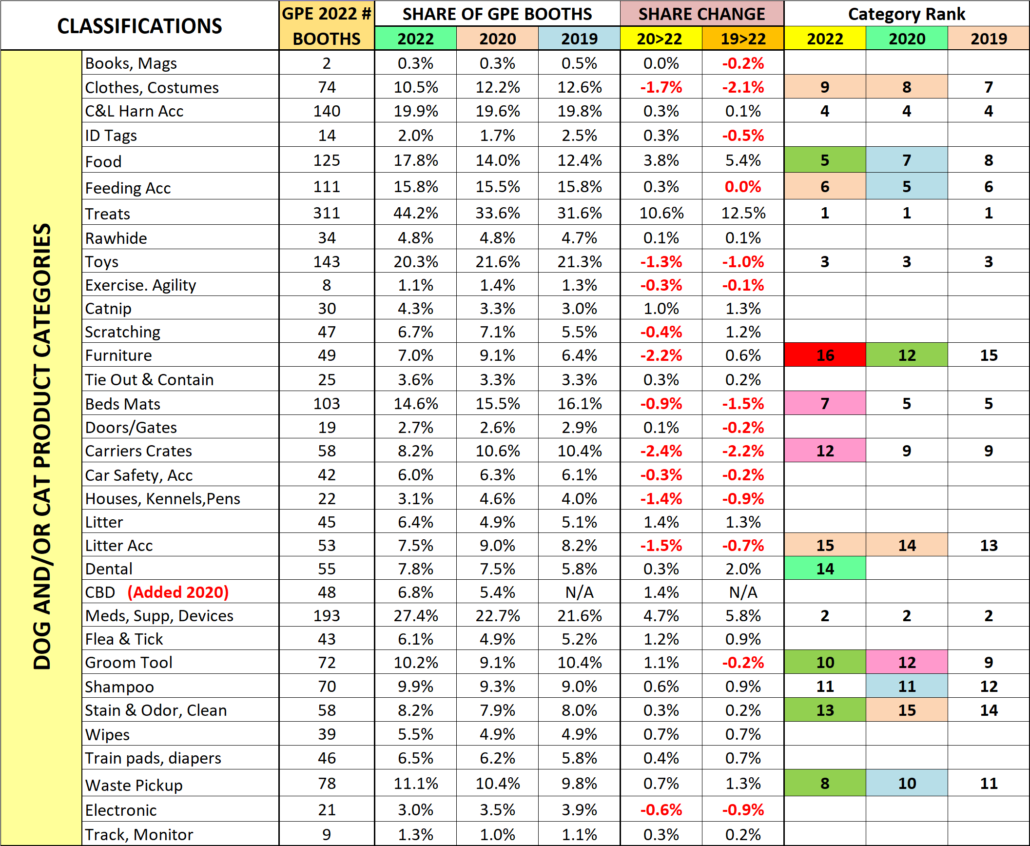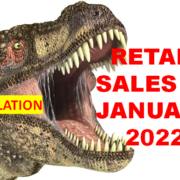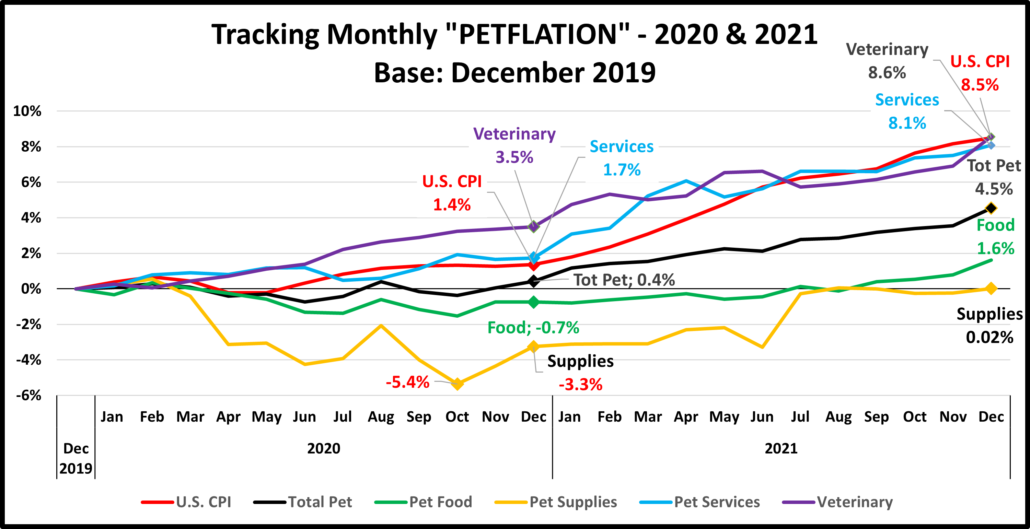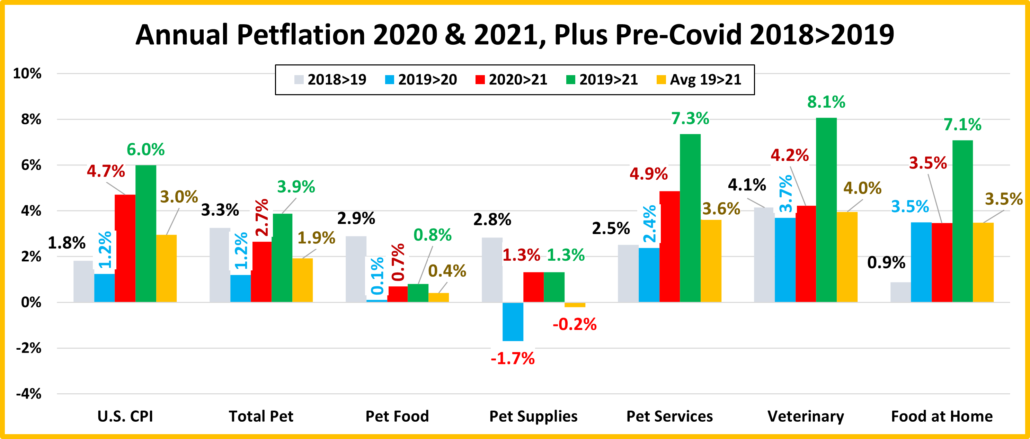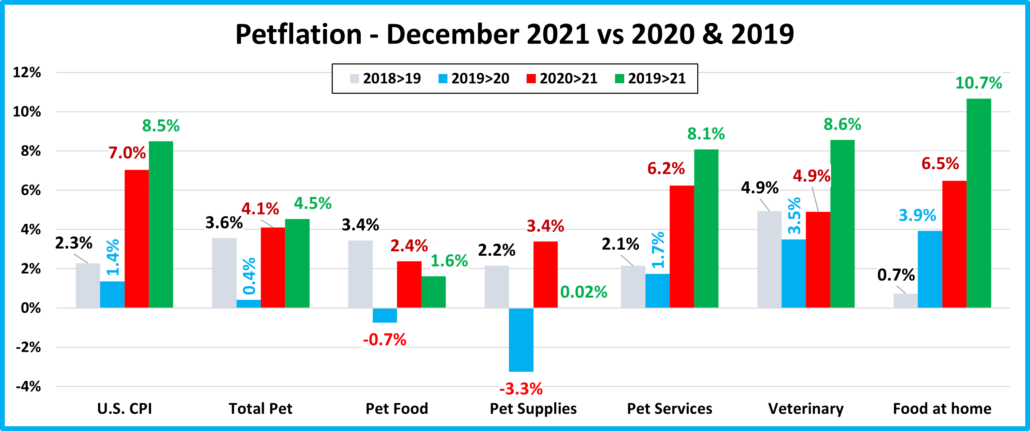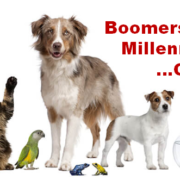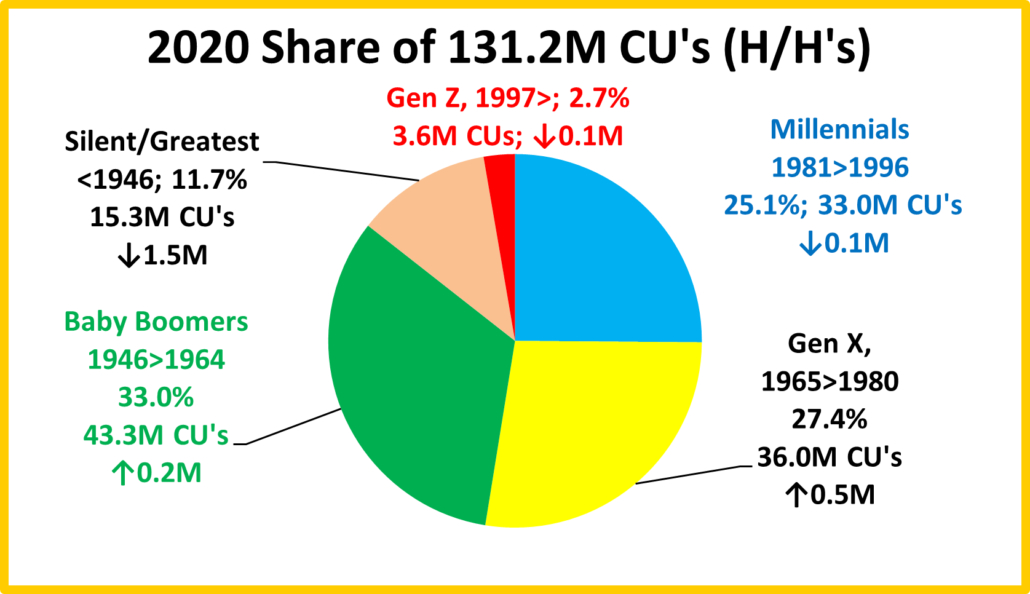The Retail recovery has been generally successful, but a long and complex journey. Now, we are seeing a new and largely unexpected factor also attributed to COVID – extreme inflation. Since this can affect retail sales, we will continue to track the retail market with data from two reports provided by the Census Bureau and add in the CPI from US BLS.
The Census Bureau Reports are the Monthly and the Advance Retail Sales Reports. Both are derived from sales data gathered from retailers across the U.S. and are published monthly at the same time. The Advance Report has a smaller sample size so it can be published quickly – about 2 weeks after month end. The Monthly Final Report includes data from all respondents, so it takes longer to compile the data – about 6 weeks. Although the sample size for the Advance report is smaller, the results over the years have proven it to be statistically accurate with the final monthly reports. The biggest difference is that the full sample in the Final report allows us to “drill” a little deeper into the retail channels.
We begin with the Final Retail Report for December and then move to the Advance Report for January, giving us a final look at 2021 and a 1st look at 2022. In the December Final we will compare 2021 to both 2020 and 2019. In the January Advance we will compare 2022 to the 3 prior years and add in the Avg Annual Change. Note: January Monthly $ = YTD.
Both reports include the following:
- Total Retail, Restaurants, Auto, Gas Stations and Relevant Retail (removing Restaurants, Auto and Gas)
- Individual Channel Data – This will be more detailed in the “Final” reports, and we fill focus on Pet Relevant Channels
The information will be presented in detailed charts to facilitate visual comparison between groups/channels of:
- Current Month change – % & $ vs previous month
- Current Month change – % & $ vs same month in 2020 and 2019 (In the Advance, we compare 2022 to 21,20 & 19)
- Current YTD change – % & $ vs 2020 and 2019 (In the Advance, YTD is unnecessary, so we add the Avg chge)
- Monthly and Year To Date $ will also be shown for each group/channel
First, the December Final. Retail hit bottom in April 2020 but began recovery, hitting record $ in December. $ fell in Jan>Feb but set a new $ records in March & May. Sales slowed through September but turned up in October, setting new records in November & December. Here are the major retail groups. (All $ are Actual, Not Seasonally Adjusted)

The final total is $2.3B less than the Advance report projected a month ago. 2 groups were up and 2 were down. The specifics were: Restaurants: +$0.7B; Gas Stations: +$0.5B; Auto: -$1.4B; Relevant Retail: -$2.0B. Sales vs November were up for all groups but Gas Stations. Total Retail $ales broke $600B for the 1st time in December 2020. December 2021 $ales broke the $700B barrier. Restaurants & Gas Stations had a truly strong December vs 2020 as their recovery strengthens. Auto had the strongest recovery with 23.5% growth in 2021 producing an annual YTD growth rate since 2019 of +11.3%. A slight $ dip in December is normal for Gas Stations but all groups contributed to setting a new $ record. Importantly, for the 7th consecutive month, all groups were positive in all measurements vs 2020 or 2019.
Now, let’s see how some Key Pet Relevant channels did in December.
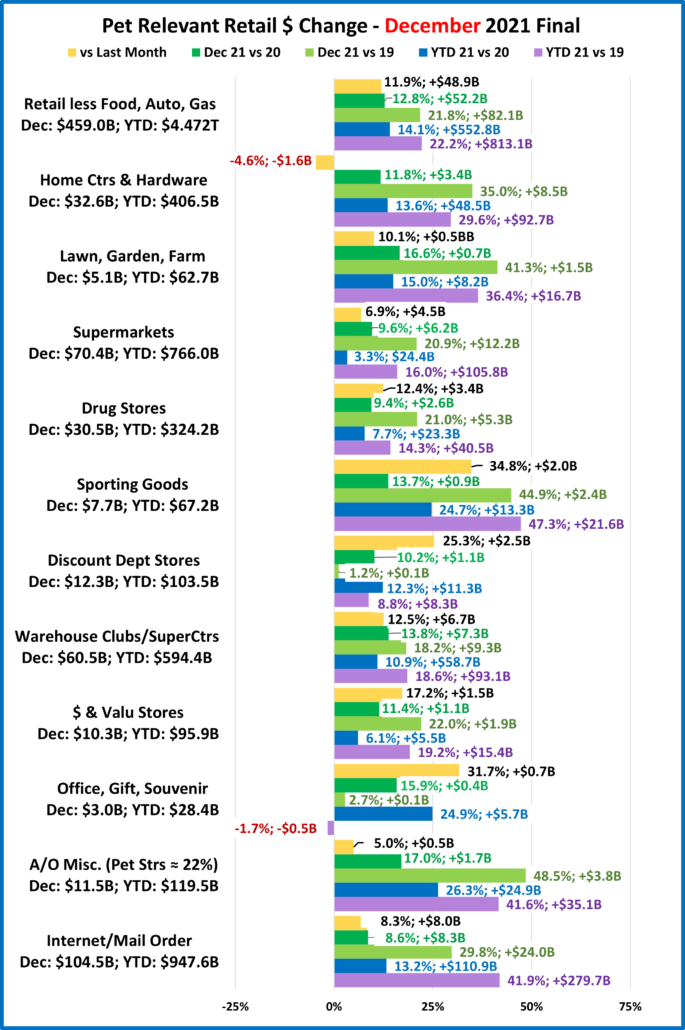
- Overall – 1 was down vs last month. A December dip in Home Ctr/Hrdwre is not unusual. Office/Gift/Souvenir $ had a strong month but are still down at yr-end vs 2019. December set another new $ record for Relevant Retail.
- Building Material Stores – Their amazing lift has slowed as we move into winter. The surge came from pandemic spending patterns developed in 2020. Consumers began focusing on their homes. Their Spring lift slowed in 2021 but Building and Farm stores are still going strong. Sporting Goods stores have a similar pattern. Sales took off in May 2020, set a record in December and continued strong in 2021. They slowed in the Spring/Summer but set a record in November, then exploded in December. Yr-end they are +47.3% vs 2019, a Growth Rate of 21.4%!
- Food & Drug – Supermarkets were +$77.7B in 2020. $ are up vs November and +9.6% vs December 2020. 2021 $ were +3.3% vs the 2020 binge and +16.0% vs 2019. Drug Stores were +$17B (+5.7%) for 2020. They had a record March. Sales then stabilized until hitting a new record in December. They finished 2021 at +7.7%.
- General Merchandise Stores – $ in all channels fell in Jan/Feb then spiked in March. Monthly sales by channel varied up/down until all stores turned up in October & set a new GM $ record in December. Clubs/SuprCtrs & $ Stores are leading the way with a combined annual growth rate of +8.9%. These channels promote value. Their success reinforces its consumer importance. Disc. Dept. Strs again show all positive numbers, growing at 4.3%.
- Office, Gift & Souvenir Stores– $ were up +31.7% vs November and they finished the year up 24.9% vs 2020. However, they were still down -1.7% vs 2019. Things have improved but full recovery is pushed into 2022.
- Internet/Mail Order – Their December sales broke the $100B for the first time and they finished the year +13.2% vs 2020. This comes on top of a 25.3% lift last year and generates an average growth rate of 19.1%
- A/O Miscellaneous – This is a group of specialty retailers which includes Florists, Art Stores and Pet Stores (22>24% of total $). In May 2020 they began their recovery. December 2021 was their 8th consecutive month over $10B and set a new record, $11.5B. Yearend $ are +26.3% vs 2020 and +41.6% vs 2019. Avg Growth: 19.0% – 3rd
Relevant Retail began recovery in May 2020 and hit record $ in December. In 2021 $ fell in Jan/Feb, turned up again in March and began a monthly up/down rollercoaster. December $ brought records for both monthly and annual sales. Moreover, all but 1 channel were ahead of all 2020 & 2019 measurements. The big drivers continue to be the Internet, SuperCtrs/Clubs/$ Stores and Hdwe/Farm. Now, the Advance numbers for January.
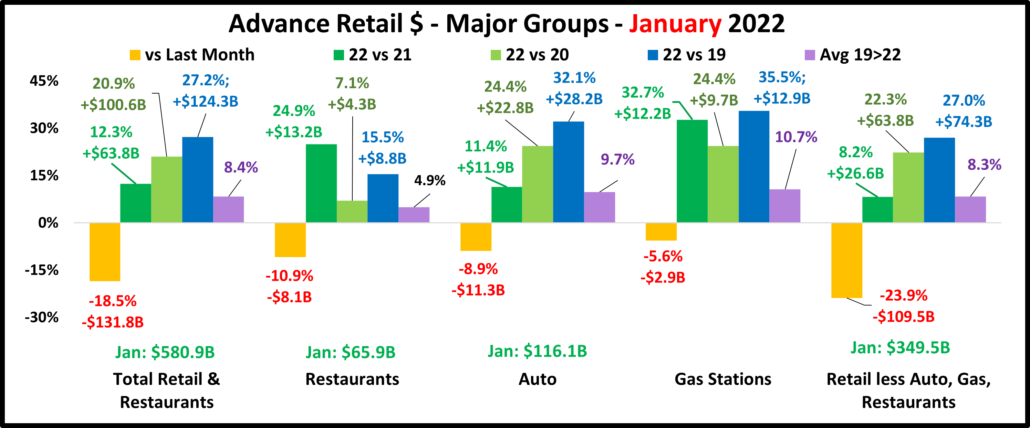
We have now had 2 straight memorable years. 2020 saw the 2 biggest monthly drops in history but Total Retail finished by reaching $600B for the first time in December. In 2021, the recovery strengthened with all big groups positive in all measurements vs 2019 & 2020 for the final 7 months. Total Retail reached $713B in December and broke the $7T barrier for the year. Relevant Retail was also strong as annual sales reached $4T but in fact, all big groups set annual sales records in 2021. Some channels are still suffering but the Retail market made a widespread, strong recovery. That brings us to 2022. First, let me issue a warning. You will see universal drops in sales from December and some will be huge. This is to be expected and totally normal. Here is the average Dec>Jan $ drop for the 10 years prior to the pandemic:
Total Retail: -20.2%
Restaurants: -8.0%
Auto: -11.5%
Gas Stations: -4.1%
Relevant Retail: -26.5%
The other factor on everyone’s mind is inflation. We will address that issue, especially when we look at the change in sales vs January 2021. Now, let’s get started.
Overall – The only negative numbers are vs December. We should also note that the January sales patterns since 2019 look pretty normal for Total Retail, Relevant Retail and Auto with year over year increases. Remember, January 2020 was pre-pandemic and by January 2021, only Restaurants and Gas Stations had not begun a strong recovery.
Total Retail – Sales in 2021 were up $1.2T (+19.4%) vs 2020, with an annual growth rate of 9.4% since 2019, the best in history. It took 2 years to recover from the Great Recession in 2009. This time it appears that we effectively accomplished it in 1 year. Annual inflation for 2021 vs 2020 was +4.7% so 75.8% of the 19.4% increase was real – 14.7%. In January, sales fell -18.5% from December, which is slightly less than a “normal” -20.2%. This is impressive since December sales reached an all-time high. However, January sales also set a record for the month, beating the previous best in 2021 by 12.3%. Although 2022 is the best performer, January sales for Total Retail have increased regularly since 2019 with an average annual lift of 8.4%. Jan 22 vs Jan 21 – Inflation = +7.5%. “Real” $ increase = +4.8% (39% of 12.3%) Inflation could be starting to have an impact.
Restaurants – They were hit hard by the pandemic and didn’t truly start to recover until March 2021. However, sales in 7 of the last 8 months of 2021 exceeded $70B. December $ were a record for the month and 2021 was the biggest year in history, $821B. January sales fell 10.9% from December, a little higher than their usual 8.0%, but were up 24.9% from 2021. Their January sales pattern clearly reflects their late recovery as sales are only up an average of 4.9% since 2019. Jan 22 vs 21 – Inflation: Food away from home = +6.4%; “Real” $ increase = +18.5% (74.3%). Damn Good!
Auto (Motor Vehicle & Parts Dealers) – Staying at home causes your car to be less of a focus but this group actively worked to overcome this attitude with great deals and a lot of advertising. They finished 2020 up 1% vs 2019 and the last 10 months of 2021 were the biggest in history, generating a record $1.54T in 2021. Their growth rate from 2019>21 averaged +11.3%, the best of any big group. In January 2022, sales fell -11.3%, minimally better than their normal -11.5%. Sales increased 11.4% in January vs 2021. You an see that the biggest increases occurred in 2021 and 2022 but they also have a pretty normal January growth pattern, with an annual average increase of +9.7%. Jan 22 vs 21 – Inflation: Overall = +7.5%; New & Used Vehicles = +23.1%. This means that at best the Real $ increase was +3.9%. The worst and more likely case is that there was actually a decrease in the amount sold in the Auto group.
Gas Stations – Gas Stations were also hit hard. If you stay home, you drive less and obviously need less gas. This group truly started recovery in March 2021. They were positive vs 2019 & 2020 for the last 10 months of 2021 and reached a record $588B (+36.7%) for the year. January sales were down -5.6% from December, slightly more than their usual -4.1%. However, they were up 32.7% vs 2021. You can see that they have a January sales pattern that is similar to Restaurants but more extreme which is evident by their 10.7% 2019>22 growth rate, which is twice as high. Inflation comes to the forefront in this group because the spectacular rise in gasoline prices has generated a lot of headlines in the media. Jan 22 vs Jan 21 – Gasoline Inflation = +40.0%. “Real” $ change = -7.3%. Spend more but get less.
Relevant Retail – Less Auto, Gas and Restaurants – This is considered the “core” of U.S. retail and traditionally accounts for about 60+% of Total Retail Spending. The channels in this group took a variety of paths through the pandemic due to many factors, like closures, binge buying, online shopping and consumers’ focus on “home”. However, their only down month was April 2020. They finished 2020, up +7.1% and 2021 got even better. March>December were 10 of the 12 biggest months of all time and helped generate a record $4.47T, +14.1% in 2021. They have led the way in Total Retail’s recovery with an average annual growth rate from 2019 of +10.6%. The recovery was primarily driven by Nonstore, Grocery, SuperCtrs/Clubs/$ Stores and Hardware/Farm but it became widespread with help from channels like Sporting Goods and even Miscellaneous Stores (includes Pet). In January sales fell -23.9% from December but still set a record for the month. This looks like a big decrease but is actually less than the normal drop of -26.5%. It reinforces the importance of December holiday sales to this group. Sales in January were +8.2% vs 2021 and almost equal to their annual growth rate of +8.3% since 2019. Their January sales pattern shows regular growth since 2019 but the biggest lift occurred in 2021 as more channels became productive and they strongly kicked off what was to become a record year. Jan 22 vs Jan 21 – Inflation = +7.5%. “Real” $ increase = +0.7% (8.5% of 8.2%). This is concerning as inflation has stopped, at least temporarily, the real growth in this huge, segment that is critically important to the U.S. Retail Marketplace.
In the groups with the strongest recovery from COVID, Relative Retail and Auto, monthly increases are slowing so we are now starting to see the effect of strong inflation. Now, we’ll look at what is happening in the individual retail channels. Remember, the groups in the chart are less defined than in the Final Monthly reports and we will look across the whole market, not just pet relevant outlets. Also remember the 7.5% inflation rate to put the $ changes into better perspective.

Everyone was down vs December and the January Sales of Electronics & Appliance Stores have been slowly falling since 2019. Sporting Goods were down a little vs 2021 but all other channels showed increases vs every year.
After hitting bottom in April 2020, Relevant Retail has now beat the previous year’s $ for 21 consecutive months. They set an all-time record of $406.8B in December and finished 2020 +$260B vs 2019. 2021 was even stronger with record sales in every month and a new record of $461.0B in December & Yr-end, $4.47T. Essential channels were the drivers:
- Nonstore Retailers
- Food & Beverage – Grocery
- Bldg Materials/Garden/Farm
- SuperCtrs/Club/Value/$ Strs
That brings us to 2022. Relevant Retail was up 8.2% vs 2021 but inflation was 7.5%, so the real increase was about 0.7%. In fact, only 7 of 13 channels had a year over year sales increase over 7.5% and some were just barely over.
General Merchandise Stores – Sales fell sharply vs December, especially in Department Stores, -50.3%. In terms of increase vs 2021, they beat inflation with +10.3% but sales growth was strong because of 2 straight years of decline. Average growth is only 1.9%. Clubs/SuperCtrs/$ stores didn’t beat inflation, but their annual average growth rate is 8.1%. They are the key to the future of the GM channel. Here are the actual and “real” increases from 2021.
- All GM: +6.4%, Real = -1.1%; Dept Stores: +10.3%, Real = +2.8%; Club/SuprCtr/$: +5.8%, Real = -1.7%
Food and Beverage, plus Health & Personal Care Stores – These stores are more essential and depend on frequent purchases so the drop from December was less severe. They had similar January lifts but the average increase for Grocery/Food & Beverage, +7.0% is twice that of Health/Drug stores, +3.5%. (BTW: Grocery Inflation was +7.4% vs 2021)
- Food & Bev: +7.2%, Real = -0.2%; Grocery: +8.1%, Real = +0.7%; Health/Drug Stores: +7.7%, Real = +0.2%
Clothing and Accessories; Electronic & Appliances; Home Furnishings – A big drop from December, especially for Clothing but they have mostly recovered. The January order pattern and growth rate shows an earlier and stronger recovery for Furniture. Electronic/Appliance is just now back to 2019 $ and continued their pattern of January declines.
- Clothing: +19.1%, Real = +11.6%; Electronic/Appliance: -3.0%, Real = -10.5%; Furniture: +1.5%, Real = -6.0%
Building Material, Farm & Garden & Hardware –Their Dec>Jan drop was small, as expected. They have benefited from consumers focusing on their home needs. They ended 2020 (+14.3%) and 2021 (+13.5%) and continued strong into January with a 12.7% increase over 2021 so they’re still beating inflation 2022 = +12.7%, Real = +5.2%
Sporting Goods, Hobby and Book Stores – Consumers turned their attention to personal recreation and sales in Sporting Goods outlets took off. The group ended 2020 +7.0% vs 2019 and 2021 was up an incredible +28.6%. January was down -44.3% from December and even down -0.8% from 2021, reducing its avg growth from 14.5% to 9.2%. Their incredible record setting run may have come to an end and stabilized at a new, higher level. 2022 = -0.8%%, Real = -8.3%.
All Miscellaneous Stores – Pet Stores have been a key part of the strong and still growing recovery of this group. They finished 2020 +0.9% but sales took off in March 2021, hitting a record $17.1B in December. Sales fell an average amount in January but were still 13.2% ahead of 2021 which was the 2nd best, behind Clothing Stores. This put their average January growth rate at +11.4%, second only to Nonstore Retailers. 2022 = +13.2%, Real = +5.7%
NonStore Retailers – 90% of the volume of this group comes from Internet/Mail Order/TV. The pandemic accelerated the movement to online retail. They ended 2020 +21.4%, +162.9B. This was 63% of the entire increase for Relevant Retail. Sales growth continued in 2021 and in December monthly sales exceeded $100B for the 1st time. For the year, they finished +13.6% and also broke the $1 Trillion barrier. January sales fell -25.4% from December but were +8.9% vs 2021 and they maintained the highest average rate of increase, +13.6%. 2021 = +8.9%, Real = +1.4%
Note: Almost without exception, online sales by brick ‘n mortar retailers are recorded with their regular store sales.
Recap – 2020 was quite a year, with the trauma of April & May followed by the triumph of breaking $600B for the first time in December. 2021 was even more memorable as it produced record sales for all major groups and Total Retail exceeded $7T for the 1st time. Relevant Retail was the major driver in this recovery. Since May of 2020 their sales have exceeded 2020 and 2019 in all measurements and reached $4.47T in 2021. The recovery was widespread as all but 2 groups on our Advance Chart set sales records in 2021. January began pretty normally for Relevant Retail with a -23.9% drop from December. This is slightly less than average and actually very good considering the record Holiday sales in 2021. With the strong retail recovery, another unexpected issue has come to the forefront, runaway inflation. The CPI is rising at year over year rates that haven’t been seen in decades. The retail recovery means a return to “normal” which includes smaller, more “normal” sales increases. Right now, sales continue to increase. Consumers often pay more but get less. As we’ve seen in the Pet Industry, strong inflation can severely reduce sales. We’ll keep tracking the retail market.





